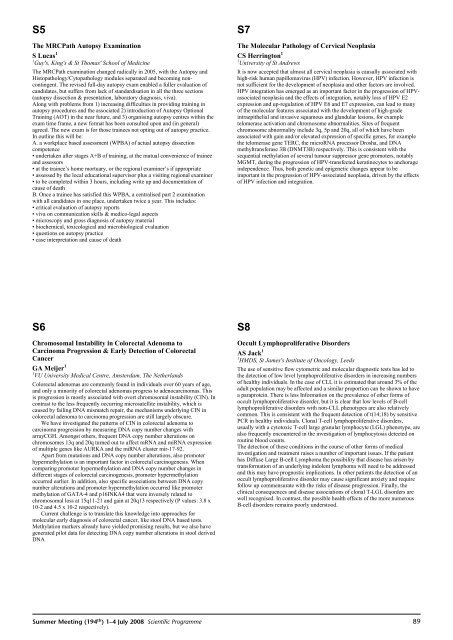2008 Summer Meeting - Leeds - The Pathological Society of Great ...
2008 Summer Meeting - Leeds - The Pathological Society of Great ...
2008 Summer Meeting - Leeds - The Pathological Society of Great ...
You also want an ePaper? Increase the reach of your titles
YUMPU automatically turns print PDFs into web optimized ePapers that Google loves.
S5<strong>The</strong> MRCPath Autopsy ExaminationSLucas 11 Guy's, King's & St Thomas' School <strong>of</strong> Medicine<strong>The</strong> MRCPath examination changed radically in 2005, with the Autopsy andHistopathology/Cytopathology modules separated and becoming noncontingent.<strong>The</strong> revised full-day autopsy exam enabled a fuller evaluation <strong>of</strong>candidates, but suffers from lack <strong>of</strong> standardisation in all the three sections(autopsy dissection & presentation, laboratory diagnosis, viva).Along with problems from 1) increasing difficulties in providing training inautopsy procedures and the associated 2) introduction <strong>of</strong> Autopsy OptionalTraining (AOT) in the near future, and 3) organising autopsy centres within theexam time frame, a new format has been consulted upon and (in general)agreed. <strong>The</strong> new exam is for those trainees not opting out <strong>of</strong> autopsy practice.In outline this will be:A. a workplace based assessment (WPBA) <strong>of</strong> actual autopsy dissectioncompetence• undertaken after stages A+B <strong>of</strong> training, at the mutual convenience <strong>of</strong> traineeand assessors• at the trainee’s home mortuary, or the regional examiner’s if appropriate• assessed by the local educational supervisor plus a visiting regional examiner• to be completed within 3 hours, including write up and documentation <strong>of</strong>cause <strong>of</strong> deathB. Once a trainee has satisfied this WPBA, a centralised part 2 examinationwith all candidates in one place, undertaken twice a year. This includes:• critical evaluation <strong>of</strong> autopsy reports• viva on communication skills & medico-legal aspects• microscopy and gross diagnosis <strong>of</strong> autopsy material• biochemical, toxicological and microbiological evaluation• questions on autopsy practice• case interpretation and cause <strong>of</strong> deathS7<strong>The</strong> Molecular Pathology <strong>of</strong> Cervical NeoplasiaCS Herrington 11 University <strong>of</strong> St AndrewsIt is now accepted that almost all cervical neoplasia is causally associated withhigh-risk human papillomavirus (HPV) infection. However, HPV infection isnot sufficient for the development <strong>of</strong> neoplasia and other factors are involved.HPV integration has emerged as an important factor in the progression <strong>of</strong> HPVassociatedneoplasia and the effects <strong>of</strong> integration, notably loss <strong>of</strong> HPV E2expression and up-regulation <strong>of</strong> HPV E6 and E7 expression, can lead to many<strong>of</strong> the molecular features associated with the development <strong>of</strong> high-gradeintraepithelial and invasive squamous and glandular lesions, for exampletelomerase activation and chromosome abnormalities. Sites <strong>of</strong> frequentchromosome abnormality include 3q, 5p and 20q, all <strong>of</strong> which have beenassociated with gain and/or elevated expression <strong>of</strong> specific genes, for examplethe telomerase gene TERC, the microRNA processor Drosha, and DNAmethyltransferase 3B (DNMT3B) respectively. This is consistent with thesequential methylation <strong>of</strong> several tumour suppressor gene promoters, notablyMGMT, during the progression <strong>of</strong> HPV-transfected keratinocytes to anchorageindependence. Thus, both genetic and epigenetic changes appear to beimportant in the progression <strong>of</strong> HPV-associated neoplasia, driven by the effects<strong>of</strong> HPV infection and integration.S6Chromosomal Instability in Colorectal Adenoma toCarcinoma Progression & Early Detection <strong>of</strong> ColorectalCancerGA Meijer 11 VU University Medical Centre, Amsterdam, <strong>The</strong> NetherlandsColorectal adenomas are commonly found in individuals over 60 years <strong>of</strong> age,and only a minority <strong>of</strong> colorectal adenomas progress to adenocarcinomas. Thisis progression is mostly associated with overt chromosomal instability (CIN). Incontrast to the less frequently occurring microsatellite instability, which iscaused by failing DNA mismatch repair, the mechanisms underlying CIN incolorectal adenoma to carcinoma progression are still largely obscure.We have investigated the patterns <strong>of</strong> CIN in colorectal adenoma tocarcinoma progression by measuring DNA copy number changes witharrayCGH. Amongst others, frequent DNA copy number alterations onchromosomes 13q and 20q turned out to affect mRNA and miRNA expression<strong>of</strong> multiple genes like AURKA and the miRNA cluster mir-17-92.Apart from mutations and DNA copy number alterations, also promoterhypermethylation is an important factor in colorectal carcinogenesis. Whencomparing promoter hypermethylation and DNA copy number changes indifferent stages <strong>of</strong> colorectal carcinogenesis, promoter hypermethylationoccurred earlier. In addition, also specific associations between DNA copynumber alterations and promoter hypermethylation occurred like promotermethylation <strong>of</strong> GATA-4 and p16INKA4 that were inversely related tochromosomal loss at 15q11-21 and gain at 20q13 respectively (P values: 3.8 x10-2 and 4.5 x 10-2 respectively).Current challenge is to translate this knowledge into approaches formolecular early diagnosis <strong>of</strong> colorectal cancer, like stool DNA based tests.Methylation markers already have yielded promising results, but we also havegenerated pilot data for detecting DNA copy number alterations in stool derivedDNAS8Occult Lymphoproliferative DisordersAS Jack 11 HMDS, St James's Institute <strong>of</strong> Oncology, <strong>Leeds</strong><strong>The</strong> use <strong>of</strong> sensitive flow cytometric and molecular diagnostic tests has led tothe detection <strong>of</strong> low level lymphoproliferative disorders in increasing numbers<strong>of</strong> healthy individuals. In the case <strong>of</strong> CLL it is estimated that around 3% <strong>of</strong> theadult population may be affected and a similar proportion can be shown to havea paraprotein. <strong>The</strong>re is less Information on the prevalence <strong>of</strong> other forms <strong>of</strong>occult lymphoproliferative disorder, but it is clear that low levels <strong>of</strong> B-celllymphoproliferative disorders with non-CLL phenotypes are also relativelycommon. This is consistent with the frequent detection <strong>of</strong> t(14;18) by sensitivePCR in healthy individuals. Clonal T-cell lymphoproliferative disorders,usually with a cytotoxic T-cell large granular lymphocyte (LGL) phenotype, arealso frequently encountered in the investigation <strong>of</strong> lymphocytosis detected onroutine blood counts.<strong>The</strong> detection <strong>of</strong> these conditions in the course <strong>of</strong> other forms <strong>of</strong> medicalinvestigation and treatment raises a number <strong>of</strong> important issues. If the patienthas Diffuse Large B-cell Lymphoma the possibility that disease has arisen bytransformation <strong>of</strong> an underlying indolent lymphoma will need to be addressedand this may have prognostic implications. In other patients the detection <strong>of</strong> anoccult lymphoproliferative disorder may cause significant anxiety and requirefollow up commensurate with the risks <strong>of</strong> disease progression. Finally, theclinical consequences and disease associations <strong>of</strong> clonal T-LGL disorders arewell recognised. In contrast, the possible health effects <strong>of</strong> the more numerousB-cell disorders remains poorly understood.<strong>Summer</strong> <strong>Meeting</strong> (194 th ) 1–4 July <strong>2008</strong> Scientific Programme89













